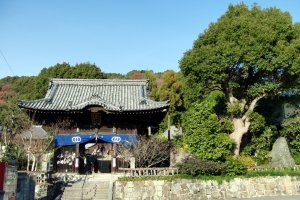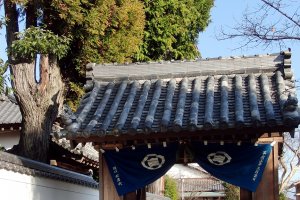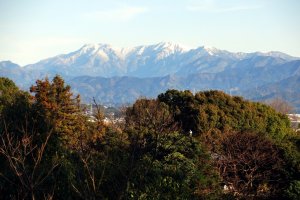I visited Jodo-ji on a winter’s afternoon in December when the sun was low in the sky but still warm. As I made my way from the car park, I was surprised to see snowy mountains off to the left in the distance. Jodo-ji is set against a row of low hills that face towards the south of Matsuyama. The temple, while generally impressive, is one of the more architecturally subdued, less spectacular of the 88 temples in Matsuyama. Compared with some of its near neighbors, it has a rustic and weathered air.
Every temple on Shikoku’s pilgrimage route has a building called the daishi-do to venerate Kobo Daishi, the founder of the pilgrimage. The one at Jodo-ji is quiet and unostentatious with a sweeping roof of elegantly weathered tiles. There always seems to be an o-henro-san pilgrim installed in front of the daishi-do reading or chanting a sutra, and Jodo-ji was no exception.
The Matsuyama Board of Education posts educational signs at all of the major temples in the city, and the one for Jodo-ji has this to say;
“Jodo-ji Temple is the 49th of the 88 sacred temples of Shikoku. According to temple records, in the early 8th century, it was built by a monk name Emyo. In the middle of the 10th century, the philanthropist Kuya Shonin arrived and spent three years here. To help people suffering from a terrible illness that was prevalent in the capital city, he left the temple. When he left, he carved a wooden statue in his own image, as was requested of him. The statue is an important cultural property.
At the end of the 12th century, Minamoto Yoritomo prayed that he and Iyo’s (historic name for Ehime Prefecture) powerful Kono clan could prosper as a single family, and had the monastery repaired. At that time, it was a large facility. From the 15th century through the 17th century, under the Kono clan, the temple played a political role and was repeatedly lost to the fire of war and later rebuilt, leading up to the temple that presently stands on this location.”
When I take part in the local autumn festival, I wear a happi coat displaying the mark of the Kono clan, the same mark that appears on the curtains hung over a gate at Jodo-ji.
Behind Jodo-ji is a hill of mixed woodland and bamboo. Spaces have been flattened for graves with rough, winding paths between, and the stones in their variety and arrangement present a quiet and harmonious scene. Wood pigeons noisily scratch around in the fallen leaves, which can be eerie – there seems to be a lot of activity among the graves, but you can’t actually see anything. One of the graves is topped by a very lifelike statue of a meditating priest. If the likeness is accurate, in life the priest must have had a very prominent, almost simian brow ridge.
Further up the hill beyond the graveyard, signposts point to a park to the right and a viewing platform to the left. I went to both, and I recommend that you give the park a miss. There’s nothing there, nor is there a view, despite the height. However, the viewing platform offers a panoramic view of the southern part of Matsuyama to the Seto Inland Sea, and some rugged mountains.



































